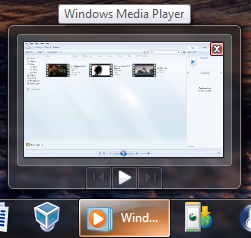Just uploaded an improved version of GraphicsSwitcher.
Changes:
– When hovering over the tray icon it is displayed which graphics adapter has been activated
NOTE: Switches made through PowerManager are not detected (That’s on my todo list for the next days).
Download
A feature I liked very much was the automatic graphics switching depending on the used power source that the Catalyst Control Center offered on my T400 in Vista. For those not knowing what I am talking about: some Lenovo notebooks are equipped with two graphics chips – one saving energy and one having more performance. In Vista / Windows 7 a dynamic switching between these chips is possible.
One (constructional?) flaw the T400 has is that only this high performance adapter is connected to the digital video output. This makes it necessary to use the high performance card for displays connected via DVI. Still I want to use the energy saving adapter when I am on the road as it gives at least 25% longer runtimes on battery.
Bottom line: Automatic switching would be great in Win 7.
Some days ago I stumbled over an article (link below) describing how to use Lenovo’s PowerManager libraries to switch the active graphics adapter and decided to implement the automatic switching myself.
To avoid trouble with Lenovo my graphics switcher does not need the PowerManager libraries in its folder but rather loads them from the PM directory (provided PM is installed).
Download GraphicsSwitcher (executable and source)
Usage:
- Extract the bin folder to a location of your choice
- Run GfxSwitcher.exe
- Automatic switching now occurs on power source changes
- To quit GraphicsSwitcher right click the belonging tray icon (right in the task bar) and click Close
Warning: Please use GraphicsSwitcher carefully (save documents before power source changes) as the current version of Lenovo’s graphics drivers are not perfect yet and tend to crash sometimes (which happens as often when you switch using PowerManager).
Licence: MIT licence, see licence.txt in the downloaded archive.
Source (graphics switching using PowerManager libraries): http://zabadab.eu/switchablegraphics/
September 11th, 2009
M.T.
For more than a month now I am enjoying Windows 7. I really enjoy it. As too many folks out there are blogging about all its greatness I did not see myself invoked to jump onto that train – until now.
Some minutes ago my mouse hovered casually above the Media Player taskbar icon – and suddenly: What is that? Controls beneath the preview? Again, one of these WOW moments.
A quick websearch brought up a nice article by Arian T. Kulp, which I can really recommend. It is about creating this and some other of the new taskbar “effects”.
Link: http://blogs.msdn.com/coding4fun/archive/2009/08/25/9874533.aspx
Today, although it would have been quite obvious by simply reading the MSDN (yes, RTFM fits in this situation), I spent some minutes searching for a way to dynamically create two mutually referencing classes via TypeBuilder. What I was looking for was a way to generate something like:
class A { public B b; }
class B { public A a; }
My first attempt was to create A without any fields, use the type to generate B and modify the former afterwards. As one cannot change a type once TypeBuilder.CreateType() has been called, that attempt failed.
After some searching I found out that TypeBuilder is a subclass of Type. Knowing this, the initial problem is easily solvable through:
TypeBuilder aBuilder = moduleBuilder.DefineType(…);
TypeBuilder bBuilder = moduleBuilder.DefineType(…);
aBuilder.DefineField("b", bBuilder, FieldAttributes.Public);
bBuilder.DefineField("a", aBuilder, FieldAttributes.Public);
aBuilder.CreateType();
bBuilder.CreateType();
Once again the simplest solution was the best.
Es war nun lange Zeit still um mich und meinen Blog. Von der hierfür eingeplanten Zeit floss ein Großteil in die Weiterentwicklung und Fertigstellung von PET.
Das plastische Akronym steht für ein Framework – entwickelt am Lehrstuhl für Software- und Systems-Engineering der TU München – welches die Forcierung von Prozessen unterstützt. Unser ursprüngliches Ziel bestand in der Abbildung eines prozessspezifisch angepassten V-Modell XT auf Microsofts Team Foundation Server 2005/08 und somit in der Ablösung des bestehenden Werkzeugs CollabXT.
Schnell stellte sich heraus, dass bei sorgfältigem Design des Frameworks eine Abbildung beliebiger Prozesse auf beliebige Tools möglich ist. PET war geboren.
Alle Besonderheiten des erstellten Frameworks aufzuzählen würde die Länge eines gut leserlichen Blog-Eintrags sprengen, deshalb hier nur einige Kernpunkte:
- Liest beliebige Prozessmodelle und erzeugt daraus Eingabedaten für prozessunterstützende Werkzeuge
- Benutzerfreundlicher Konvertierungsassistent für Windows XP, Vista, Server 2003/08
- Vollständig lokalisiert in Deutsch und Englisch
- Dynamische geladene Plugins zum Lesen des Prozessmodells
- Im aktuellen Release ist ein Plugin für das V-Modell XT enthalten
- Dynamische geladene Plugins zum Erstellen von Werkzeugvorlagen und direkten Endprodukten
- Plugins für Microsofts Team Foundation Server, SharePoint und Word 2007 liegen bereits vor
- kompletter Quelltext in C#, .NET 3.5
- Open Source
Bei Interesse verweise ich auf die Codeplex-Homepage des Projekts: http://pet.codeplex.com. Hier finden sich eine ausführliche Beschreibung des Projekts, sowie die Programmdateien. Bald folgen an gleicher Stelle der vollständige Quelltext von PET, sowie eine Ausarbeitung über die inneren Strukturen des Systems.
